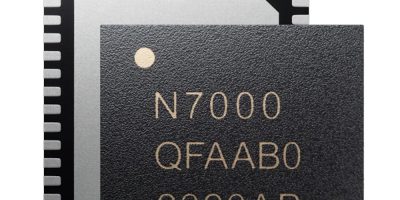Wi-Fi companion IC is first silicon-to-cloud locationing solution, says Nordic
The nRF7000 Wi-Fi companion IC is a low-power Wi-Fi 6 chip, optimised for Wi-Fi network scanning on both the 2.4- and 5GHz Wi-Fi frequency bands.
It is the final part of Nordic Semiconductor’s SSID-based Wi-Fi location solution, said the company. The nRF7000 Wi-Fi companion IC, together with Nordic’s nRF91 Series cellular IoT system in package (SiP), enables SSID-based Wi-Fi location fixing. Nordic’s SSID-based Wi-Fi enables the acquisition of accurate location fixes in a power efficient manner both indoors and outdoors, and in urban and suburban areas. Nordic explained that this is a valuable complement to GNSS, especially in buildings and in dense urban areas where GNSS can fail due to signal fading and interruptions. Scanning for Wi-Fi SSIDs for location finding is commonplace in products such as smartphones.
The nRF7000 IC is optimised for low power Wi-Fi SSID scanning and does not support data communication via Wi-Fi. The result is a balance between power consumption and location precision, said Nordic.
The nRF7000 IC is used for Wi-Fi scanning with an nRF91 series SiP for cellular communication to Nordic’s nRF Cloud. Instead of relying on traditional methods like cell towers or satellite signals, SSID-based Wi-Fi location fixing scans the signals from nearby Wi-Fi access points to accurately determine a tracker’s location. This offers a location accuracy that is better than cellular-based, said Nordic, but less accurate than GNSS, while being more power-efficient than GNSS and almost as power-efficient as cellular-based options.
“Nordic’s dedication to low power wireless technology enables us to provide highly efficient solutions for numerous IoT applications,” says Kjetil Holstad, executive vice president strategy and product management at Nordic Semiconductor. “Customers now need to come to just one place for a comprehensive, low power location-ing solution,” he said. “This streamlines the process and saves them significant time and money.”
Finn Boetius, product marketing engineer at Nordic Semiconductor, added: “Competing solutions tend to use general-purpose Wi-Fi ICs for Wi-Fi location-ing. These are usually over-sized and not optimised for this specific use case. This makes them both more expensive and more power-hungry”.
This option allows a trade-off between position accuracy and power consumption, continued Boetius. “In situations where high position precision is needed, GNSS is the best option. But if GNSS is unavailable or only a very rough location is needed, you can use cell-based locationing and save battery life; this will be accurate enough to tell you in which neighbourhood your device is. If you’re still without GNSS and need more, accurate information, you include Wi-Fi information at the cost of a little more power. This will be accurate enough to tell you in which house the device is located.”
Nordic’s SSID-based Wi-Fi locationing solution is supported by the nRF Connect SDK (software development kit), the company’s single software development environment. When used in conjunction with Nordic’s nRF Cloud Services, the SDK enables effortless over-the-air updates for application, middleware, and / or modem firmware while providing a secure and reliable update procedure.
Nordic offers the nRF7002 EK (evaluation kit) to help developers get started on location projects. The EK is supplied in an Arduino shield form factor and can easily be combined with an nRF9160 DK (Development Kit).
The nRF7000 Wi-Fi Companion IC and the nRF7002 EK are available now through Nordic’s distribution partners.




